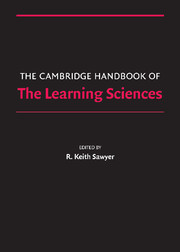Book contents
- Frontmatter
- Contents
- Preface
- Contributors
- 1 Introduction
- PART I FOUNDATIONS
- PART II METHODOLOGIES
- PART III THE NATURE OF KNOWLEDGE
- PART IV MAKING KNOWLEDGE VISIBLE
- PART V LEARNING TOGETHER
- PART VI LEARNING ENVIRONMENTS
- 28 Motivation and Cognitive Engagement in Learning Environments
- 29 Learning as a Cultural Process
- 30 Prospects for Transforming Schools with Technology- Supported Assessment
- 31 Internet Use in Schools
- 32 Teacher Learning Research and the Learning Sciences
- 33 Scaling Up
- 34 Conclusion
- Afterword: After How Comes What
- Epilogue: The Fundamental Issue in the Learning Sciences
- Author Index
- Subject Index
- References
32 - Teacher Learning Research and the Learning Sciences
Published online by Cambridge University Press: 05 June 2012
- Frontmatter
- Contents
- Preface
- Contributors
- 1 Introduction
- PART I FOUNDATIONS
- PART II METHODOLOGIES
- PART III THE NATURE OF KNOWLEDGE
- PART IV MAKING KNOWLEDGE VISIBLE
- PART V LEARNING TOGETHER
- PART VI LEARNING ENVIRONMENTS
- 28 Motivation and Cognitive Engagement in Learning Environments
- 29 Learning as a Cultural Process
- 30 Prospects for Transforming Schools with Technology- Supported Assessment
- 31 Internet Use in Schools
- 32 Teacher Learning Research and the Learning Sciences
- 33 Scaling Up
- 34 Conclusion
- Afterword: After How Comes What
- Epilogue: The Fundamental Issue in the Learning Sciences
- Author Index
- Subject Index
- References
Summary
Teacher learning is an active area for research in education, and although the learning sciences have not been primarily focused on teacher learning, teacher education, or professional development, we argue that the perspectives our field brings to the study of teachers' learning offer great promise. Learning sciences researchers – guided by the cognitive, sociocognitive, sociocultural, and systems-oriented perspectives that are prevalent in our field – have made contributions to and extended research on teacher learning in new and significant directions.
Fostering change in classroom learning and teaching is a central concern of the learning sciences, and teachers are a cornerstone of nearly all formal instructional systems. Teachers are the ultimate interpreters of any classroom-based intervention, and are responsible for a large amount of variance in the effects of instructional interventions – this is known as the “teacher effect” (Nye, Konstantopoulos, & Hedges, 2004). If learning sciences researchers are interested in translating research into practice to effect change at the classroom level – and we believe that they are – it is imperative that the field pay careful attention to how teachers learn their craft and learn to effectively enact the innovations (technologies, curricula, etc.) that emerge from learning sciences research (Fishman et al., 2004).
- Type
- Chapter
- Information
- The Cambridge Handbook of the Learning Sciences , pp. 535 - 550Publisher: Cambridge University PressPrint publication year: 2005
References
- 14
- Cited by



